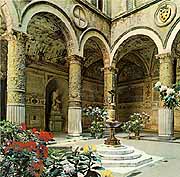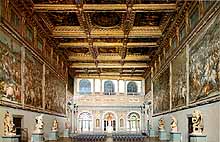
Michelozzo, Courtyard of Honour
Excusez nous mais cette page n'est pas été encore traduite en Français
The first alterations to Palazzo Vecchio date from 1342-43, during the brief tyranny of the Duke of Athens, Gualtieri di Brienne, who added to the fortress-like aspect of the building (this can be seen especially on the Via della Ninna side), and above all during the decades between 1440-60, when Cosimo"the Elder" dÈ Medici took over the government of the city. In 1446 the Signoria created a special force called "the Workmen for Work on the Palace" (first 5 and later 3) who acted as overseers. This period saw Renaissance style alterations carried out on areas like the Hall of the Two Hundred, the Residence of the Priors and the first entrance courtyard, entrusted to the design of Michelozzo (1453), who had already constructed Palazzo Medici for Cosimo in Via Larga.
The courtyard, at the time without the well in the centre, was later enriched by the fountain by Francesco del Tadda (1555-57), completed by the Putto with a dolphin on top, which had been carried out a century earlier by Verrocchio for the Medici Villa of Careggi (the original is however now in the Quarters of the Elements). The gilded stucco work and the frescoes, all showing views of the Hapsburg estates, date instead from Vasari's reconstruction, and in particular from the wedding between Francesco de' Medici, Cosimo I's heir, and Joan of Austria, sister of the Emperor (1565).
Later the Republic of Savonarola was responsible for the construction of the Hall of the Five Hundred (53 x 22 metres, 18 in height), built in 1494-96 by Cronaca (Simone di Tommaso del Pollaiolo) and by Antonio da Sangallo, Overseer of Works, for the meetings of the General Council of the People, founded by the Dominican friar. The portal above the main entrance from Piazza Signoria, with the monogram of Christ and the "Rex Regnum et Dominus Dominatium" motto (the latter added in 1851), dates instead from 1528 and was not placed there, as many guide books say, in memory of Savonarola.

Cronaca,
Hall of the Five Hundred
Cronaca also created the second courtyard, known as "the Customs" and the Chancery was built (1511) above it; one wall of this room still has one of the original "two-light" windows (transformed into a door) and the original "rustic work" from the rear facade of Arnolfo's palace .
